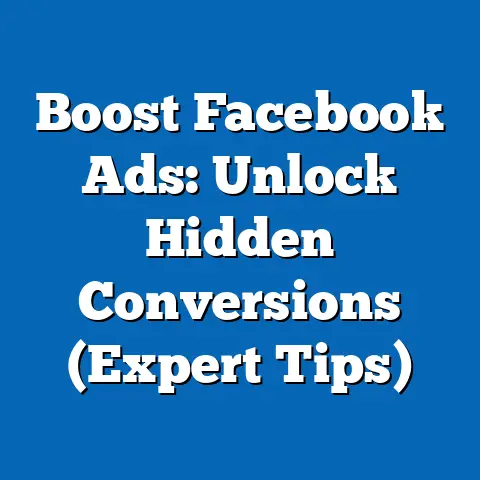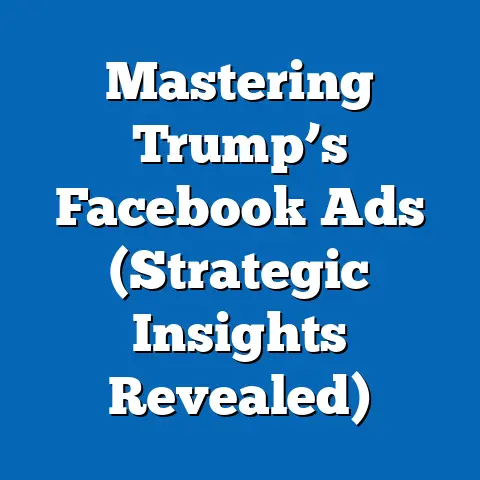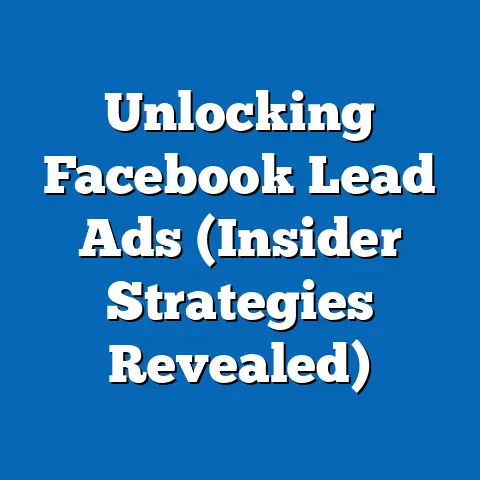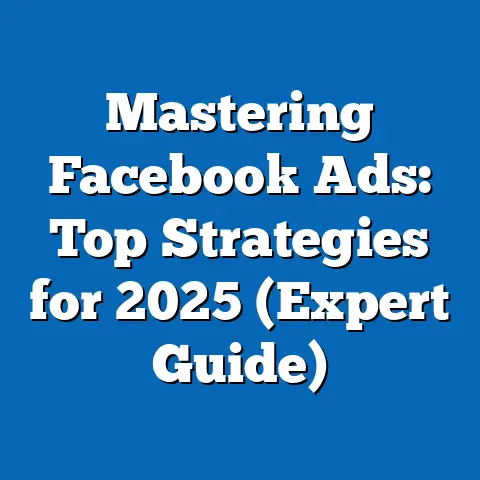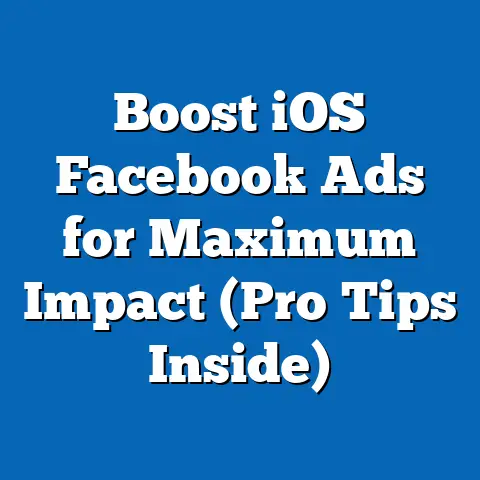Master Facebook Ad Delivery (Proven Optimization Techniques)
In the fast-paced world of digital marketing, mastering Facebook ad delivery is a critical skill for businesses aiming to maximize their return on investment (ROI). With over 2.9 billion monthly active users as of 2023, Facebook remains a dominant platform for reaching diverse audiences (Statista, 2023). However, achieving effective ad delivery—ensuring your ads reach the right people at the right time—requires strategic optimization, especially when time is of the essence.
The Urgency of Fast Facebook Ad Optimization
Time is money in digital advertising, and delays in optimizing ad delivery can result in wasted budgets and missed opportunities. According to a 2022 report by Hootsuite, businesses that optimize their Facebook ads within the first 48 hours of launch see a 25% higher click-through rate (CTR) compared to those who delay adjustments. Speed matters—whether you’re launching a flash sale or building brand awareness.
Moreover, Facebook’s ad platform operates on a real-time bidding system, where ad delivery is influenced by factors like audience targeting, bid strategy, and creative relevance. Failing to act quickly can lead to poor ad placement or higher costs per click (CPC). For instance, WordStream data from 2023 shows that the average CPC on Facebook Ads is $1.72, but unoptimized campaigns often pay up to 30% more due to inefficiencies.
Demographically, Facebook’s user base spans a wide range of age groups and regions, making rapid optimization even more critical to target the right segments. As of 2023, 31.5% of users are aged 25-34, the largest demographic group, while 18-24-year-olds and 35-44-year-olds each account for roughly 20% (Pew Research Center, 2023). Tailoring ad delivery to these groups with speed ensures relevance and engagement, especially in competitive markets.
Key Trends in Facebook Ad Delivery (2023)
Before diving into optimization techniques, it’s essential to understand the current landscape of Facebook advertising. Trends shape how ads are delivered, and staying ahead of the curve can provide a competitive edge.
-
Rise of Automation: Facebook’s Advantage+ tools, introduced in 2022, use machine learning to automate ad placement and targeting. According to Meta’s 2023 performance report, campaigns using Advantage+ see a 17% lower cost per action (CPA) on average compared to manual setups.
-
Shift to Video Content: Video ads continue to dominate engagement, with 62% of marketers reporting higher ROI from video content compared to static images (Social Media Examiner, 2023). Fast delivery of video ads is crucial as they capture attention within the first 3 seconds.
-
Mobile-First Focus: With 98.5% of Facebook users accessing the platform via mobile devices (Meta, 2023), optimizing for mobile delivery—such as ensuring fast-loading creatives—is non-negotiable for quick results.
-
Privacy-Driven Changes: Post-iOS 14.5 updates, tracking limitations have forced advertisers to adapt. A 2023 eMarketer study found that 54% of marketers now rely on first-party data and contextual targeting to maintain ad delivery efficiency.
These trends highlight the need for speed and adaptability in ad optimization. Let’s now explore demographic patterns to understand who you’re targeting and why fast adjustments matter.
Demographic Insights: Who Are You Reaching on Facebook?
Facebook’s diverse user base offers unparalleled opportunities for targeted ad delivery, but understanding demographic nuances is key to rapid success. Here’s a breakdown of critical data points from 2023 studies by Pew Research Center and Statista:
-
Age Distribution: As mentioned earlier, 25-34-year-olds form the largest group (31.5%), followed by 18-24 (20%) and 35-44 (20%). Older users (65+) are the smallest segment at 4.7%, but their engagement rates for niche products are often higher.
-
Gender Split: The platform is nearly evenly split, with 56% male and 44% female users globally. However, engagement patterns differ—women are 15% more likely to interact with lifestyle and e-commerce ads, while men show higher engagement with tech and gaming content (Hootsuite, 2023).
-
Geographic Reach: India leads with 314 million users, followed by the U.S. (179 million) and Indonesia (119 million). Urban users in these regions are 22% more likely to click on ads compared to rural users, emphasizing the need for location-specific delivery tweaks (Statista, 2023).
-
Income Levels: In the U.S., 74% of users earning over $75,000 annually are active on Facebook, compared to 60% of those earning under $30,000 (Pew Research, 2023). High-income users often convert faster on premium product ads, necessitating quick delivery adjustments for luxury brands.
These demographic insights underscore the importance of tailoring ad delivery to specific groups. Rapid optimization ensures your budget isn’t wasted on irrelevant audiences, especially in the critical early hours of a campaign.
Fast Solutions for Optimizing Facebook Ad Delivery
Now that we’ve covered the context, let’s dive into actionable, fast solutions for optimizing Facebook ad delivery. These techniques are designed to deliver quick results while setting the stage for sustained performance. Each strategy is supported by data and practical steps.
1. Leverage Facebook’s Automated Tools for Instant Impact
Facebook’s automated tools, such as Advantage+ Placements and Automated Rules, are built for speed. According to Meta, advertisers using Advantage+ Placements see a 12% increase in reach within the first 24 hours compared to manual placements (Meta, 2023).
- How to Implement: Enable Advantage+ during campaign setup to let Facebook’s algorithm test multiple placements (e.g., Feed, Stories, Reels) simultaneously. Set a clear objective (e.g., conversions or traffic) to guide the algorithm.
- Quick Tip: Monitor performance after 12 hours. If a placement underperforms (e.g., Stories yield a CTR below 1%), manually exclude it to redirect budget.
Automation reduces setup time and adapts to audience behavior in real-time, making it a go-to for fast results. However, always pair it with manual oversight to avoid over-reliance on AI.
2. Refine Audience Targeting with Lookalike Audiences
Narrowing down your audience quickly prevents ad spend leakage. Lookalike Audiences, which target users similar to your best customers, can be set up in minutes and deliver results fast. A 2022 study by WordStream found that Lookalike Audiences reduce CPA by 20% on average compared to broad targeting.
- How to Implement: Upload a customer list or use pixel data to create a 1-2% Lookalike Audience (smaller percentages are more precise). Test multiple lookalikes based on high-value actions like purchases or leads.
- Speed Factor: Results often appear within 6-12 hours as Facebook matches user profiles. Adjust audience size if impressions are low.
Demographically, tailor lookalikes to key groups (e.g., 25-34-year-olds in urban areas) for faster engagement. This ensures your ads reach high-potential users without wasting time on broad testing.
3. Optimize Creative Assets for Immediate Engagement
Ad creatives are the first touchpoint for users, and poor design can tank delivery performance instantly. HubSpot’s 2023 report notes that ads with high-quality visuals achieve a 35% higher CTR within the first day compared to generic imagery.
- Fast Fix: Use bold colors, clear text overlays, and mobile-friendly formats (1:1 or 9:16 for Stories/Reels). Test 2-3 variations using Facebook’s Dynamic Creative tool to identify winners within hours.
- Data Insight: Video ads under 15 seconds have a 60% higher completion rate (Social Media Examiner, 2023). Prioritize short, punchy content for quick impact.
Speed is critical here—upload polished creatives at launch to avoid delays in approval or low relevance scores. A relevance score below 5 can limit delivery, so prioritize quality from the start.
4. Set Aggressive Bid Strategies for Rapid Reach
Facebook’s auction system rewards competitive bids with better delivery. For time-sensitive campaigns, opting for a “Lowest Cost with Bid Cap” strategy can accelerate impressions. According to Meta, campaigns with bid caps see a 15% faster delivery rate in the first 24 hours (Meta, 2022).
- How to Apply: Start with a bid cap 20-30% above the average CPC for your industry (e.g., $2.20 for e-commerce, per WordStream 2023). Monitor cost per result after 12 hours and adjust downward if costs spike.
- Caution: High bids can deplete budgets quickly. Use with daily spend limits to maintain control.
This approach is ideal for flash sales or urgent promotions where speed trumps long-term cost efficiency. Pair it with tight targeting to avoid overspending on low-value clicks.
5. Monitor and Adjust Frequency Caps Early
Ad fatigue sets in quickly if users see your ad too often, reducing delivery efficiency. A 2023 study by AdEspresso found that a frequency above 3 (views per user) within 48 hours leads to a 40% drop in CTR.
- Quick Solution: Set a frequency cap of 2-3 impressions per user per week at launch. Check frequency metrics in Ads Manager after 12-24 hours and lower the cap if engagement drops.
- Demographic Note: Younger users (18-24) are more prone to ad fatigue, with a 50% higher likelihood of hiding repetitive ads (Hootsuite, 2023). Adjust caps tighter for this group.
Fast intervention on frequency prevents wasted impressions and keeps delivery optimized for fresh eyes. This is especially crucial for smaller audiences where repetition is inevitable.
Historical Trends vs. Current Data: Evolution of Ad Delivery
Understanding how Facebook ad delivery has evolved provides context for why fast optimization is more critical now than ever. Let’s compare historical data with current trends.
-
2018-2020 (Pre-Privacy Era): Before Apple’s iOS 14.5 update, advertisers relied heavily on third-party tracking, with 85% of campaigns using retargeting for delivery (eMarketer, 2019). Average CPA was lower at $18.50 compared to $23.40 in 2023 (WordStream). Optimization took days as data was abundant and precise.
-
2021-2023 (Post-Privacy Era): Tracking limitations reduced retargeting effectiveness, with only 45% of marketers using it today (eMarketer, 2023). Automation and first-party data now drive delivery, necessitating faster adjustments—often within hours—to counter data gaps. Delivery speed has become 30% more critical due to shorter learning phases (Meta, 2023).
Historically, marketers had more time to refine campaigns, but today’s environment demands rapid action. The shift to automation and mobile-first delivery also means ads must perform instantly or risk irrelevance.
Data Visualization: Understanding Delivery Performance
To grasp the impact of fast optimization, imagine a line graph tracking CTR over the first 72 hours of a campaign. The X-axis represents time (hours), and the Y-axis represents CTR (percentage).
1. A/B Testing for Long-Term Insights
Run split tests on audiences, creatives, and placements to identify top performers. A 2023 HubSpot study shows A/B testing improves conversion rates by 28% over 7 days. Start with fast tests (24-48 hours) on small budgets, then scale winning variants.
2. Custom Conversions for Precision Tracking
Set up custom conversions to track specific actions (e.g., “Add to Cart” or “Newsletter Signup”). Meta reports a 19% higher ROI for campaigns with custom events compared to standard objectives (Meta, 2023). This takes setup time but refines delivery over weeks.
3. Retargeting with Dynamic Ads
Use dynamic ads to re-engage users who interacted with your brand. WordStream notes a 60% higher conversion rate for retargeting campaigns, though privacy changes require creative workaround (e.g., first-party data). Start retargeting after initial fast optimizations are in place.
These advanced tactics complement rapid fixes, ensuring your ad delivery remains efficient beyond the first few days.
Broader Implications and Future Trends
Mastering Facebook ad delivery with fast optimization techniques offers immediate benefits—higher CTR, lower CPA, and better reach—but it also prepares marketers for the future of digital advertising. As privacy regulations tighten and AI-driven tools expand, the ability to adapt quickly will remain a competitive advantage.
Looking ahead, expect even greater reliance on automation, with Meta projecting that 80% of ad campaigns will use AI tools like Advantage+ by 2025 (Meta Investor Report, 2023). Additionally, short-form video content (e.g., Reels) will likely dominate ad delivery, with engagement projected to grow by 40% annually (Social Media Examiner, 2023).
For businesses, the takeaway is clear: invest in speed now to stay relevant later. Whether you’re a small business or a global brand, mastering fast optimization ensures your ads cut through the noise in an increasingly crowded digital space.
Conclusion
Facebook ad delivery is both an art and a science, requiring rapid action and data-driven decisions to achieve results. By leveraging automated tools, refining targeting, optimizing creatives, adjusting bids, and monitoring frequency, marketers can see significant improvements within hours. Backed by statistics—such as a 25% higher CTR for early optimization (Hootsuite, 2022)—these fast solutions are proven to work across demographics and industries.
As the platform evolves, staying agile will be key. Use the strategies outlined in this article to start strong, then build on them with advanced techniques for long-term success. With 2.9 billion users waiting to be reached, the time to master Facebook ad delivery is now.

